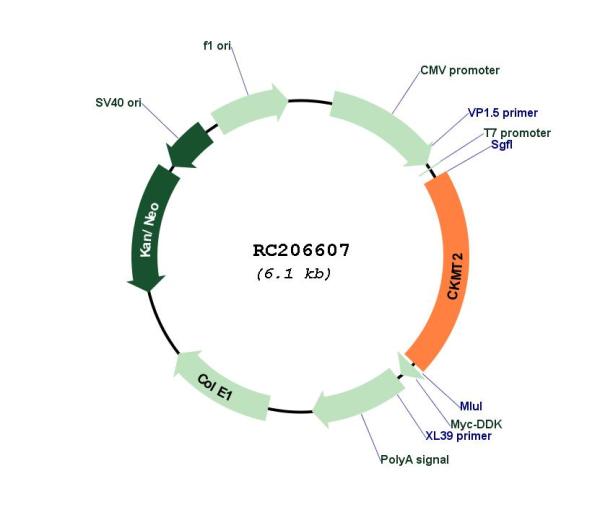CKMT2 (NM_001825) Human Tagged ORF Clone
CAT#: RC206607
CKMT2 (Myc-DDK-tagged)-Human creatine kinase, mitochondrial 2 (sarcomeric) (CKMT2), nuclear gene encoding mitochondrial protein, transcript variant 1
ORF Plasmid: tGFP
Lentiviral Particles: DDK DDK w/ Puro mGFP mGFP w/ Puro
AAV Particle: DDK
"NM_001825" in other vectors (6)
USD 198.00
Specifications
| Product Data | |
| Type | Human Tagged ORF Clone |
| Tag | Myc-DDK |
| Symbol | CKMT2 |
| Synonyms | SMTCK |
| Vector | pCMV6-Entry |
| E. coli Selection | Kanamycin (25 ug/mL) |
| Mammalian Cell Selection | Neomycin |
| Sequence Data |
>RC206607 ORF sequence
Red=Cloning site Blue=ORF Green=Tags(s) TTTTGTAATACGACTCACTATAGGGCGGCCGGGAATTCGTCGACTGGATCCGGTACCGAGGAGATCTGCC GCCGCGATCGCC ATGGCCAGTATCTTTTCTAAGTTGCTAACTGGCCGCAATGCTTCTCTGCTGTTTGCTACCATGGGCACCA GTGTCCTGACCACCGGGTACCTGCTGAACCGGCAGAAAGTGTGTGCCGAGGTCCGGGAGCAGCCTAGGCT ATTTCCTCCAAGCGCAGACTACCCAGACCTGCGCAAGCACAACAACTGCATGGCCGAGTGCCTCACCCCC GCCATTTATGCCAAGCTTCGCAACAAGGTGACACCCAACGGCTACACGCTGGACCAGTGCATCCAGACTG GAGTGGACAACCCTGGCCACCCCTTCATAAAGACTGTGGGCATGGTGGCTGGTGACGAGGAGTCCTATGA GGTGTTTGCTGACCTTTTTGACCCCGTCATCAAACTAAGACACAACGGCTATGACCCCAGGGTGATGAAG CACACAACGGATCTGGATGCATCAAAGATCACCCAAGGGCAGTTCGACGAGCATTACGTGCTGTCTTCTC GGGTGCGCACTGGCCGCAGCATCCGTGGGCTGAGCCTGCCTCCAGCCTGCACCCGGGCCGAGCGAAGGGA GGTAGAGAACGTGGCCATCACTGCCCTGGAGGGCCTCAAGGGGGACCTGGCTGGCCGCTACTACAAGCTG TCCGAGATGACGGAGCAGGACCAGCAGCGGCTCATCGATGACCACTTTCTGTTTGATAAGCCAGTGTCCC CTTTATTAACATGTGCTGGGATGGCCCGTGACTGGCCAGATGCCAGGGGAATCTGGCATAATTATGATAA GACATTTCTCATCTGGATAAATGAGGAGGATCACACCAGGGTAATCTCAATGGAAAAAGGAGGCAATATG AAACGAGTATTTGAGCGATTCTGTCGTGGACTAAAAGAAGTAGAACGGTTAATCCAAGAACGAGGCTGGG AGTTCATGTGGAATGAGCGCCTAGGATACATTTTGACCTGTCCTTCGAACCTTGGAACAGGACTACGAGC TGGTGTCCACGTTAGGATCCCAAAGCTCAGCAAGGACCCACGCTTTTCTAAGATCCTGGAAAACCTAAGA CTCCAGAAGCGTGGCACAGGTGGTGTGGACACTGCCGCGGTCGCAGATGTGTACGACATTTCCAACATAG ATAGAATTGGTCGATCAGAGGTTGAGCTTGTTCAGATAGTCATCGATGGAGTCAATTACCTGGTGGATTG TGAAAAGAAGTTGGAGAGAGGCCAAGATATTAAGGTGCCACCCCCTCTGCCTCAGTTTGGCAAAAAG ACGCGTACGCGGCCGCTCGAGCAGAAACTCATCTCAGAAGAGGATCTGGCAGCAAATGATATCCTGGATT ACAAGGATGACGACGATAAGGTTTAA >RC206607 protein sequence
Red=Cloning site Green=Tags(s) MASIFSKLLTGRNASLLFATMGTSVLTTGYLLNRQKVCAEVREQPRLFPPSADYPDLRKHNNCMAECLTP AIYAKLRNKVTPNGYTLDQCIQTGVDNPGHPFIKTVGMVAGDEESYEVFADLFDPVIKLRHNGYDPRVMK HTTDLDASKITQGQFDEHYVLSSRVRTGRSIRGLSLPPACTRAERREVENVAITALEGLKGDLAGRYYKL SEMTEQDQQRLIDDHFLFDKPVSPLLTCAGMARDWPDARGIWHNYDKTFLIWINEEDHTRVISMEKGGNM KRVFERFCRGLKEVERLIQERGWEFMWNERLGYILTCPSNLGTGLRAGVHVRIPKLSKDPRFSKILENLR LQKRGTGGVDTAAVADVYDISNIDRIGRSEVELVQIVIDGVNYLVDCEKKLERGQDIKVPPPLPQFGKK TRTRPLEQKLISEEDLAANDILDYKDDDDKV |
| Chromatograms |
CHROMATOGRAMS
 Sequencher program is needed, download here. |
| Restriction Sites |
SgfI-MluI
Cloning Scheme for this gene
Plasmid Map

|
| ACCN | NM_001825 |
| ORF Size | 1257 bp |
| OTI Disclaimer | The molecular sequence of this clone aligns with the gene accession number as a point of reference only. However, individual transcript sequences of the same gene can differ through naturally occurring variations (e.g. polymorphisms), each with its own valid existence. This clone is substantially in agreement with the reference, but a complete review of all prevailing variants is recommended prior to use. More info |
| OTI Annotation | This clone was engineered to express the complete ORF with an expression tag. Expression varies depending on the nature of the gene. |
| Product Components | The ORF clone is ion-exchange column purified and shipped in a 2D barcoded Matrix tube containing 10ug of transfection-ready, dried plasmid DNA (reconstitute with 100 ul of water). |
| Reconstitution | 1. Centrifuge at 5,000xg for 5min. 2. Carefully open the tube and add 100ul of sterile water to dissolve the DNA. 3. Close the tube and incubate for 10 minutes at room temperature. 4. Briefly vortex the tube and then do a quick spin (less than 5000xg) to concentrate the liquid at the bottom. 5. Store the suspended plasmid at -20°C. The DNA is stable for at least one year from date of shipping when stored at -20°C. |
| Reference Data | |
| RefSeq | NM_001825.2 |
| RefSeq Size | 1650 bp |
| RefSeq ORF | 1260 bp |
| Locus ID | 1160 |
| UniProt ID | P17540 |
| Cytogenetics | 5q14.1 |
| Domains | ATP-gua_Ptrans |
| Protein Families | Druggable Genome |
| Protein Pathways | Arginine and proline metabolism, Metabolic pathways |
| MW | 47.5 kDa |
| Gene Summary | Mitochondrial creatine kinase (MtCK) is responsible for the transfer of high energy phosphate from mitochondria to the cytosolic carrier, creatine. It belongs to the creatine kinase isoenzyme family. It exists as two isoenzymes, sarcomeric MtCK and ubiquitous MtCK, encoded by separate genes. Mitochondrial creatine kinase occurs in two different oligomeric forms: dimers and octamers, in contrast to the exclusively dimeric cytosolic creatine kinase isoenzymes. Sarcomeric mitochondrial creatine kinase has 80% homology with the coding exons of ubiquitous mitochondrial creatine kinase. This gene contains sequences homologous to several motifs that are shared among some nuclear genes encoding mitochondrial proteins and thus may be essential for the coordinated activation of these genes during mitochondrial biogenesis. Three transcript variants encoding the same protein have been found for this gene. [provided by RefSeq, Jul 2008] |
Documents
| Product Manuals |
| FAQs |
| SDS |
Resources
Other Versions
| SKU | Description | Size | Price |
|---|---|---|---|
| RC206607L1 | Lenti ORF clone of Human creatine kinase, mitochondrial 2 (sarcomeric) (CKMT2), nuclear gene encoding mitochondrial protein, transcript variant 1, Myc-DDK-tagged |
USD 757.00 |
|
| RC206607L2 | Lenti ORF clone of Human creatine kinase, mitochondrial 2 (sarcomeric) (CKMT2), nuclear gene encoding mitochondrial protein, transcript variant 1, mGFP tagged |
USD 757.00 |
|
| RC206607L3 | Lenti ORF clone of Human creatine kinase, mitochondrial 2 (sarcomeric) (CKMT2), nuclear gene encoding mitochondrial protein, transcript variant 1, Myc-DDK-tagged |
USD 757.00 |
|
| RC206607L4 | Lenti ORF clone of Human creatine kinase, mitochondrial 2 (sarcomeric) (CKMT2), nuclear gene encoding mitochondrial protein, transcript variant 1, mGFP tagged |
USD 757.00 |
|
| RG206607 | CKMT2 (tGFP-tagged) - Human creatine kinase, mitochondrial 2 (sarcomeric) (CKMT2), nuclear gene encoding mitochondrial protein, transcript variant 1 |
USD 657.00 |
|
| SC321700 | CKMT2 (untagged)-Human creatine kinase, mitochondrial 2 (sarcomeric) (CKMT2), nuclear gene encoding mitochondrial protein, transcript variant 1 |
USD 457.00 |
{0} Product Review(s)
Be the first one to submit a review






























































































































































































































































 Germany
Germany
 Japan
Japan
 United Kingdom
United Kingdom
 China
China





